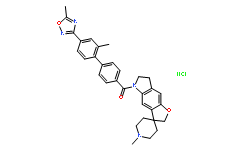| DC33635 |
DODAP
|
DODAP, also known as 1,2-Dioleoyl-3-dimethylammonium-propane, is a cationic lipid. It has been used as a component in liposomes that can be used to encapsulate siRNA, immunostimulatory oligodeoxynucleotides, antisense oligonucleotides, or chemotherapeutic agents for in vitro and in vivo delivery. |
| DC31074 |
Isopropyl myristate
|
Isopropyl myristate is the ester of isopropyl alcohol and myristic acid. |
| DC74583 |
ZK53
|
ZK53 is a selective activator of mitochondrial caseinolytic protease P (HsClpP). It exhibits an EC50 of 1.37 μM for α-casein hydrolysis by HsClpP. ZK53 treatment allosterically activates HsClpP to uncontrollably degrade the essential mitochondrial proteins and is inactive toward bacterial ClpP proteins. |
| DC74576 |
Fluorofurimazine
|
Fluorofurimazine is a novel furimazine analogue, with increased aqueous solubility enabling higher signal emission than furimazine for bioluminescence imaging. Fluorofurimazine enables higher substrate loading and improved optical imaging sensitivity in in-vivo. |
| DC74557 |
PREX-in1
|
PREX-in1 is a specific small-molecule inhibitor of P-Rex1 and P-Rex2 Rac-GEF activity with IC50 of 4.5 uM (P-Rex1 DHPH Rac-GEF activity) in liposome-based GEF assay, inhibits P-Rex1 and P-Rex2 through their catalytic DH domain. |
| DC74555 |
GYS32661
|
GYS32661 (GYS 32661) is a potent Rac inhibitor capable of inhibiting both Rac1 and Rac1b, inhibited activated Rac1 with IC50 of 1.18 uM in in vitro pull-down assays. |
| DC74539 |
L557-0155
|
L557-0155 is a small molecule inhibitor of VSIG-8, prevents VSIG-8 binding to VISTA, promotes cytokine production and cell proliferation in PBMCs and suppresses melanoma growth. |
| DC74528 |
K284
|
K284 is a selective small molecule inhibitor of chitinase 3 like1 (CHI3L1) with strong binding affinity (Kd=-9.7 kcal·mol-1), inhibits lung metastasis by blocking IL-13Rα2-mediated JNK-AP-1 signals. |
| DC74247 |
AG-946
|
AG-946 (AG946) is a potent, allosteric activator of wild-type and mutant RBC-specific form of pyruvate kinase (PKR) with AC50 of 5 nM for human wild-type PK, 4.3 nM and 6.9 nM for mutated K410E and R510Q PK proteins, resepctively. |
| DC74241 |
Rebecsinib
|
Rebecsinib (17S-FD-895) is a selective small-molecule inhibitor of splicing-mediated ADAR1 activation, prevents leukemia stem cell generation. |






















